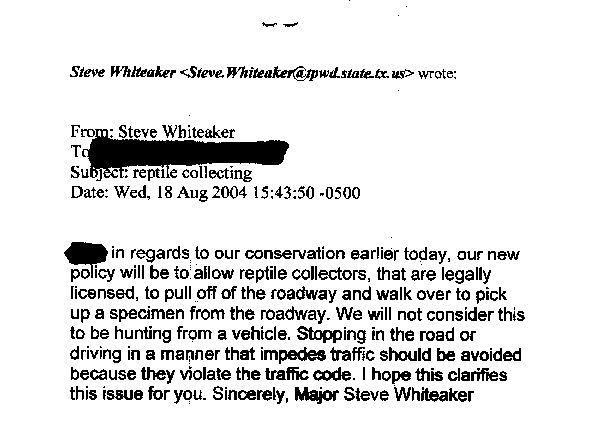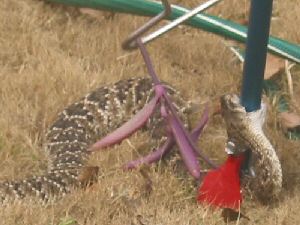|
|
|
| In an ideal scenario, one would always
have the appropriate equipment. However, sometimes that's
not always possible--I often find reptiles when I'm not
specifically looking for them and therefore am unprepared to
"do anything about it," such as capture them for a
closer look, take notes, or even take a picture.
Planned "field herping" outings can be more
productive if you have the following equipment (I've tried to list
them in order of importance):
License/Permit | Field
Guides | Camera | Field
Hooks/Tongs | Flashlights
If you're looking for herping techniques, click
here.
|

NEW for 2004:
The above email from TX Parks & Wildlife is valuable to carry
in your vehicle if you plan on road-cruising
Texas. Click here or
click the image for a larger, printable-size version (274KB).
For more clarification on this policy from
TPWD's Chief of Law Enforcement, click here. |
| The
Appropriate License/Permit: Many people don't even
consider this aspect, as reptiles aren't typically held in the
same regard as "big game." However, most states
and countries regulate the capture of their reptile species, even
if you plan on releasing them immediately after taking a
photo. In some cases, even "pursuing" or
"stalking" a reptile (for example, to get closer for a
photograph) is considered "hunting" and requires a
license.
Doing things "the right way" by purchasing a license
or permit is critical for many reasons. First and foremost
(as far as most people are concerned), it keeps you from getting
fined or jailed for poaching. Even more important, from a
wildlife management standpoint, the monies collected from the sale
of licenses funds the governmental agencies' wildlife conservation
programs (which receive little to no financial support from
general tax revenue).
A quick search on the World Wide Web for "department
natural resources" or "wildlife regulations" for
the state or country in question will usually turn up the
pertinent licensing information. You will also find the
specific regulations regarding reptiles (usually under
"nongame species") such as bag limits and restrictions
on individual species. I have listed what I could find
online regarding reptile regulations for the United States (by
individual state) in the columns at right.
Be sure to plan ahead; some permitting processes can take
several weeks and may require completion of a Hunter Education
course.
Some states and countries (such as Australia)
may forbid any capture of native reptiles by non-residents.
Please respect such restrictions and capture only with film.
If in doubt, call ahead and inquire about local regulations and
permits.
back to top
|
Links
to Herping Law Info
NOTE: These links are to information provided by each
state's applicable agency. Check the currency of the
information. Links presented here may not be authoritative
and may be superseded by newer information. IF YOU HAVE AN
UPDATED LINK, PLEASE CONTACT ME (any email addressed to the
McMartinVille.com domain) and I will update the info presented
here. |
- AL
- AK
- No herp regs listed!
- AR
- PDF format; scroll to bottom of page 24
- AZ
- PDF format
- CA
- PDF format; section 5.05 for amphibians and 5.60 for
reptiles.
- CO
- PDF format; scroll to page 2 for game reptiles
- CT
- DE
- PDF format; scroll to bottom of page 21
- DC
- FL
- GA
- PDF format; scroll to page 8 under "protected
species"
- HI
- ID
- IL
- IN
- IA
- PDF format; scroll to page 21
- KS
- PDF format; see p4 and p6
- KY
- Scroll to Section 3.(7)--thanks to James Blair of the KHS
for the link!
- LA
- Herp
Society Link
- ME
- MD
- MA
- PDF format; scroll to page 6
- MI
- PDF format; scroll to page 13
- MN
- MS
- MO
-
-
|
- MT
- NE
- NV
- Scroll to bottom
- NH
- NJ
- PDF format
- NM
- NY
- PDF format; see pp7-9
- NC
- ND
- PDF format; scroll to page 45
- OH
- PDF format
- OK
- PDF format; scroll to page 14
- HTML
version
- OR
- PA
- Rhode
Island
- PDF format; scroll to page 29
- SC
- PDF format; rules vary depending on location--scroll entire
document
- SD
- PDF format; scroll to page 10 under "Bait"
- TN
- TX
- UT
- VT
- PDF format; scroll to section G3.0
- VA
- WA
- WV
- PDF format; scroll to page 3 under "Gigging"
- WI
- PDF format
- WY
|
| Field Guides:
Try to find a good field guide as specific as possible for the
area you'll be herping. There are a couple of guides that
cover the entire United States, for example, but if you're
primarily going to be herping only a few states, there are many
excellent state and regional guides available. Click
here for a short list of field guides I own and recommend
(some are better than others, though). By clicking through
to Amazon from my page, I will receive a percentage of the sales
price (transparent to you; it doesn't cost you any more than
normal) which helps to justify all the time I spend maintaining
this site! Thanks in advance!
back to top
|
|
| Cameras:
The enjoyment of observing reptiles in their natural surroundings
is rewarding in itself, but having a photographic record of your
experiences provides the opportunity to share your finds with
others (as I've done on this site, and many
others do as well).
If you are in the market for a new(er) camera, consider a
digital camera for its ease of editing and posting online, as well
as the freedom to take lots of pictures and not worry about film,
discarding the "bad" shots and choosing to print only
the best ones.
Other important features include a decent zoom capability (as
many reptiles won't allow you to approach closer than a few yards)
and a variable-intensity flash (so you can "turn it
down" to avoid washing out close-up shots of reptiles at
night).
I use a Canon
PowerShot G2 (the G3 is the current iteration) which I've had
since August 2002. While I don't have a separate zoom lens,
its 4-megapixel resolution allows me to crop the pictures down to
the item of interest and still end up with a large, clear image.
Also consider the use of a video camera. This is useful
for capturing interesting behaviors, locomotion, etc. or even for
recording footage in the hopes of grabbing a still image later
(I've done that on several of my Reptiles pages here). I've
had a Sony
DCR-TRV820 (linked DCR-TRV350 is comparable) since 2000, which
records a digital signal onto Hi-8mm tape. It has a FireWire
output which allows me to edit the footage and grab stills on my
computer. While the resolution isn't as good as that of my
camera, it allows me to get shots I'd otherwise miss.
back to top
|
|
| Field Hooks and/or
Tongs: These come in all shapes and sizes. I
currently have 3 of these implements: a "standard"
field hook, a collapsible field hook, and "Gentle Giant"
tongs.
The standard field hook is advantageous because it's one piece
and serves three purposes: as a hook for pinning or lifting
snakes, as an implement for flipping
artificial cover, and as a walking stick/brace.
The collapsible hook basically functions like the standard
field hook, but it telescopes down to a small size which makes it
convenient for travel (fits in a backpack). The main
drawback is that it's not quite as sturdy for use in pinning.
The "Gentle Giant" tongs (shown at right) are
great. The contact surface is wide, which spreads the
pressure over more of a snake's body as compared to the
traditional, narrow "back breaker" tongs. I have
the model that folds in half which helps in travel.
I get my equipment from Midwest
Tongs.com, and you should too! Why? If you
purchase from them using the link here, I will get a small
percentage for referring you, which will help offset my expenses
in running this site. It doesn't cost you any more to do
this, and it would be greatly appreciated. Also, they have a
wide variety of reptile-related products and I am very satisfied
with my own purchases from them.
|

|
| Potato Rake: As odd as it
may sound, a potato rake (also known as a tined cultivator) is an
excellent field herping tool. It is primarily used for
flipping ground cover, and can also be used to rake through leave
litter to find specimens. The wooden handle of the rake
gives it excellent rigidity, and the multiple tines make it easier
to flip objects than by using a field hook (more stability
afforded by the tines). Potato rakes can be purchased at
most gardening or home supply stores.
back to top
|
 |
| Flashlights:
If you do any night herping, a flashlight is essential.
Everyone has their favorite, including some specially-made
"rigs" for illuminating road cuts. Personally, I
do well enough with more of a standard (and cheaper!)
flashlight. I use flashlights powered by a lantern battery
instead of "C" or "D" cells. My current
flashlight is an Eveready two-way flashlight/lantern. It
provides a good spotlight capability and converts to an area
lantern for general illumination.
I also have a headlamp--nothing fancy, just a basic Eveready
Waterproof Headlamp. I've found I don't use it as much as
the basic handheld variety--I feel a little self-conscious wearing
it!
back to top
|
|
|
|
|
Up | Laws &
Equipment | Methods | US
Reptile Identification | My Trips | My
Life List | Other Peoples' Pages |
|
|
|
|
|
|
|
|
|
|
|